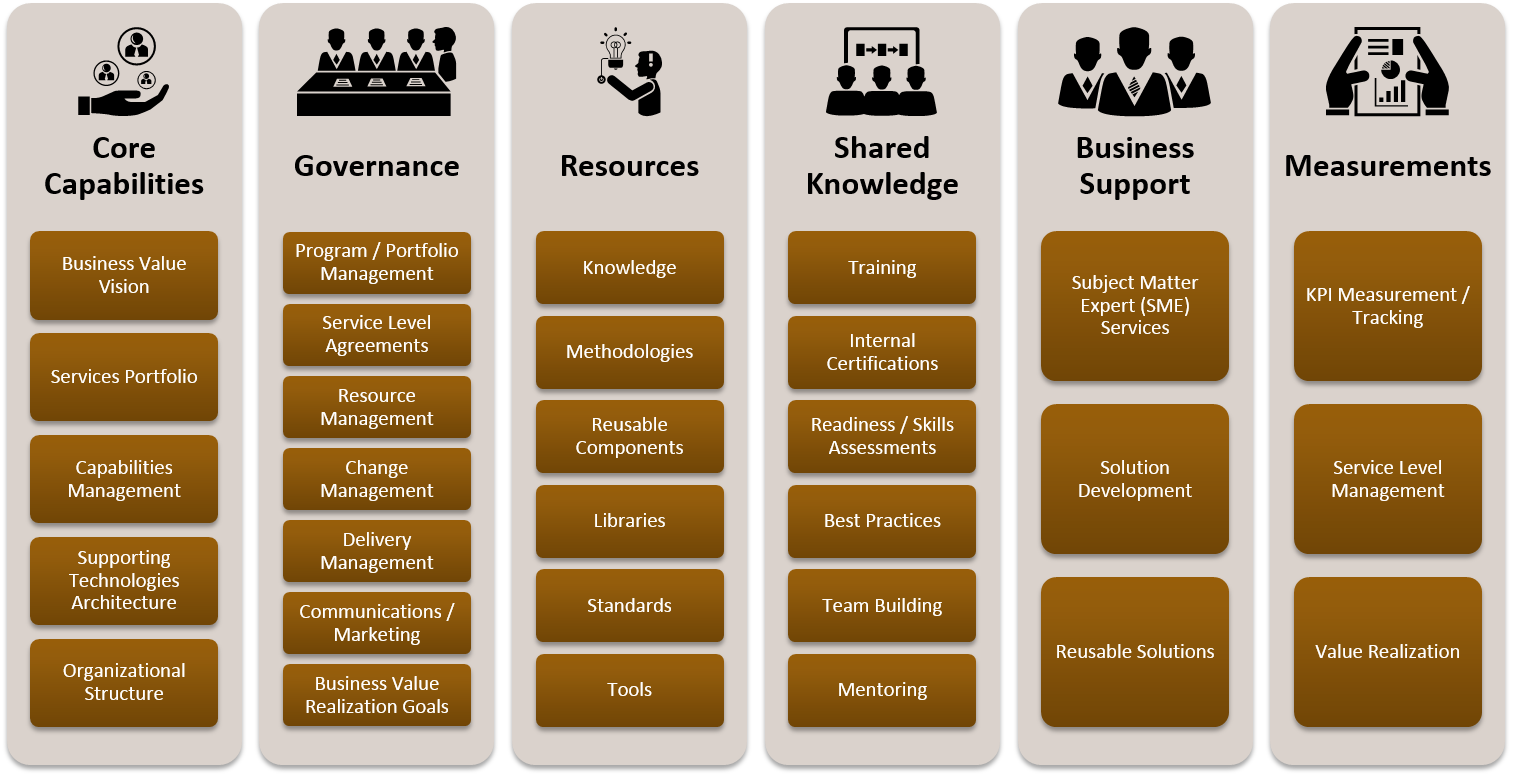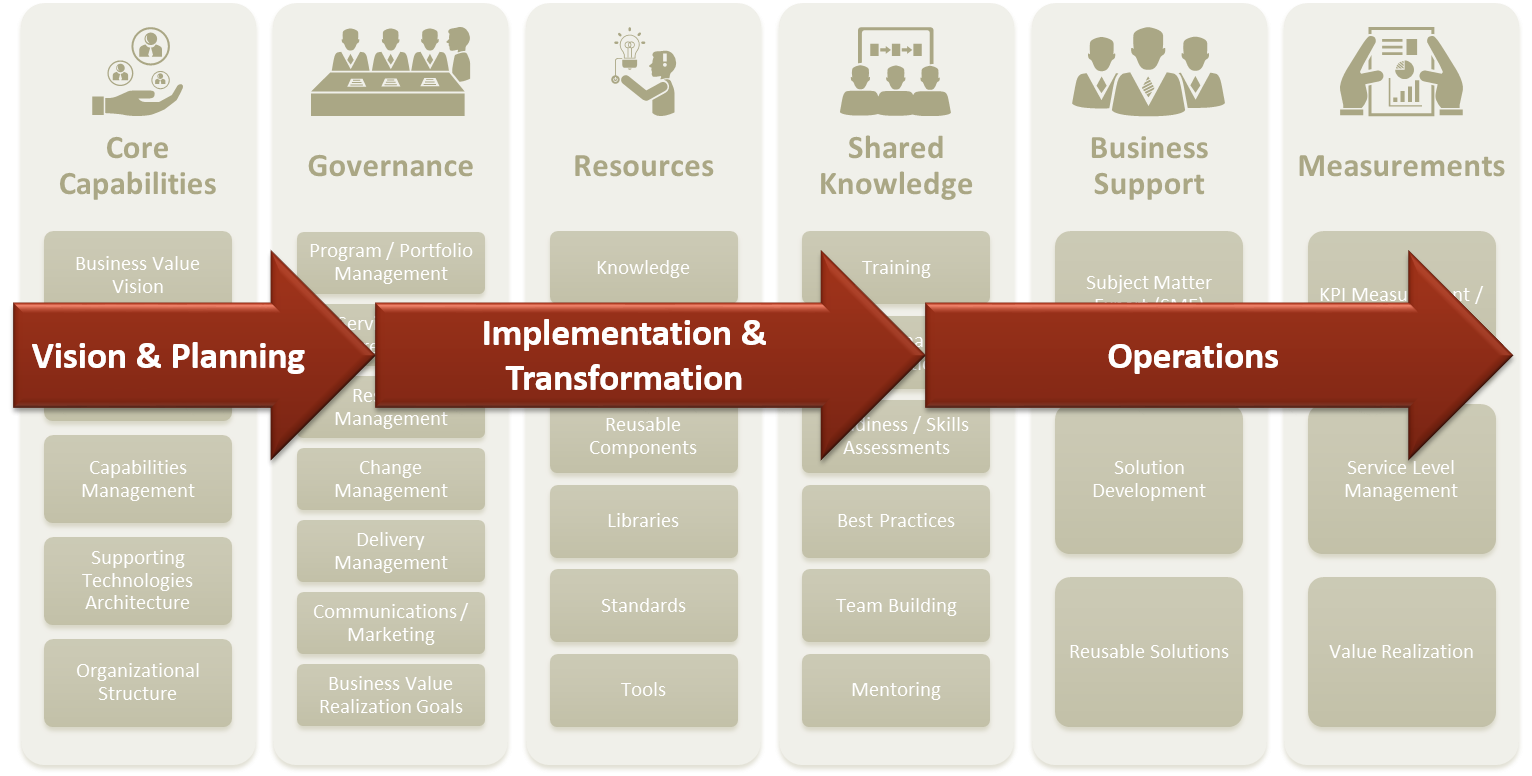Center of Excellence
A Center of Excellence provides expertise and builds organization capabilities in a specific domain such as project management. More importantly it focuses on initiatives with the highest business value and drives the realization of that value.
ArborSys has developed a Center-of-Excellence (CoE) methodology and process to encourage innovation and deliver business value to its clients and partners. A CoE focuses on the design and development of solutions to address challenges specific to a business or a technology domain, while proactively building internal competencies. A CoE focuses on extending the competencies in specific areas of need such as:
- Business Process Management (BPM)
- Electronic Content Management (ECM)
- Structured Content Management (SCM)
- Change Management
- Business Analysis
- Cloud Solutions
- Enterprise Social Collaboration and Knowledge Management
It may also focus on particular technologies such as Appian, Azure, Documentum, or SharePoint. A CoE promotes collaboration and the use of best practices around a specific focus area to drive business results and value.
The ArborSys CoE Methodology and Process
We assist our clients in establishing the CoE model that is right for their organization and needs. Once the CoE is established, we work with our clients to staff the CoE with qualified resources to sustain the capabilities and deliver services.
Our CoE model is comprised of six component functions that are essential elements of a successful CoE. Each component contains building blocks necessary to implement and operate a successful CoE.

Core Capabilities are the functional backbone of the CoE. They are its purpose and underlying support structure.
Governance is oversight and guidance to assure that CoE resources are allocated across the organization and focus on the highest value projects. It is the structure and organization that ensures alignment with business strategy and direction on an ongoing basis.
Resources are CoE staff and the acquired assets of knowledge, methodologies, reusable components, libraries, standards, tools, etc., that the CoE uses to deliver value to the business rapidly.
Shared Knowledge is built within the business and the CoE through training, internal certifications, readiness and skill assessments, best practices, team building, and mentoring.
Business Support is the actual delivery of service by the CoE within its area of focus. This may be in the form of full-service solutions or subject matter expertise or both.
Measurements demonstrate the value of the CoE and the results achieved by the business units served by the CoE.
How We Work With You
ArborSys delivers CoE services across and within three phases: Vision & Planning, Implementation & Transformation, and Operations. These phases draw upon the building blocks of our CoE model.
During the Vision & Planning phase, we work with you to develop a vision and strategy for the CoE organization that focuses on business value and how that value is realized. This phase develops the Core Capabilities of the CoE. Beginning with your business strategy, a focused portfolio of services, capabilities, technologies, and resources is envisioned that will achieve realized business value. The result is the Roadmap to the CoE future state.

The vision and strategies developed in the first phase are executed in the Implementation & Transformation phase. Any gaps between the current and future state are identified in this second phase. Our services in this phase focus on the internal processes that pertain to the project/program management, solution planning, development, and communication of the CoE capabilities to business units. Projects are prioritized based on potential value, time to market, risk, etc. CoE capabilities are increased and leveraged across other business units and projects.
The Operations phase is ongoing service delivery and service support of business units by the CoE. This not only includes ongoing project and portfolio management, but the measurement of KPIs, service levels, and value realization.
Value and Benefits
The specific benefits of a CoE vary depending upon its business or technology focus. In general, a CoE allows a company to develop a core service area rather than a series of isolated projects applying that same core service. It establishes an internal focal point of expertise for that core service. It better aligns resources by reducing project redundancies. A CoE cultivates better and more repeatable skills. It facilitates crossing functional and business unit boundaries. It also leverages investments, especially technology investments.
Additionally, there are a number of specific benefits provided by a CoE including:
- Identifies opportunities for appropriate use of technologies
- Integrates the business process and the technology seamlessly
- Matches the scope of the solution with the business objectives
- Develops CoE champions within the enterprise
- Allows for quick response to changing business environments and technology demands
The ArborSys Difference
We help our clients align business strategies with effective, results-driven CoEs. First and foremost, we understand your business goals and needs. Additionally our CoE services are:
- Unique, modular services with multiple entry points
- Based on best practices and proven experience
- Operations based on ITIL public domain standards
- Focused on outcomes and business value
- Process driven and technology independent
ArborSys can help. We have the people, processes, and expertise to support your CoE needs.
Learn More
There is a natural funnel effect in the way projects flow through a CoE. This is especially true when the CoE is first introduced. The funnel must be narrowed by financial constraints. With limited resources the CoE should first tackle the highest value projects. How many of these are taken on is constrained by business and CoE bandwidth. The most constraining factor is capabilty. This constraint tends to slaken as the CoE develops capabilities across the organization. As capabilities increase bandwidth also tends to increase. More projects can be taken on further leveraging the value of the CoE.

A CoE is a service unit possessing capabilities visibly recognized by the organization as an important source of value creation, with the intent that those capabilities be leveraged by business operating units.
The Shared Services model was created to realize savings by creating economies of scale servicing more customers with the same resources. Some of the key differences are noted in the table below:
| Shared Services | Center of Excellence | |
|---|---|---|
| Value Proposition | Lower-cost; greater efficiency | Improved business outcomes |
| Value Creation Process | Focus on optimization and efficiency, consolidated assets, lower cost location | Access to otherwise unavailable capabilities, higher level skills and experience |
| Measurement System | Quantitative output based | Evaluative outcome based |
| Service Demand | Continuous | Need-driven |
| Ensuring Customer Service | Account managers, service center | Actual professional who does the work |
